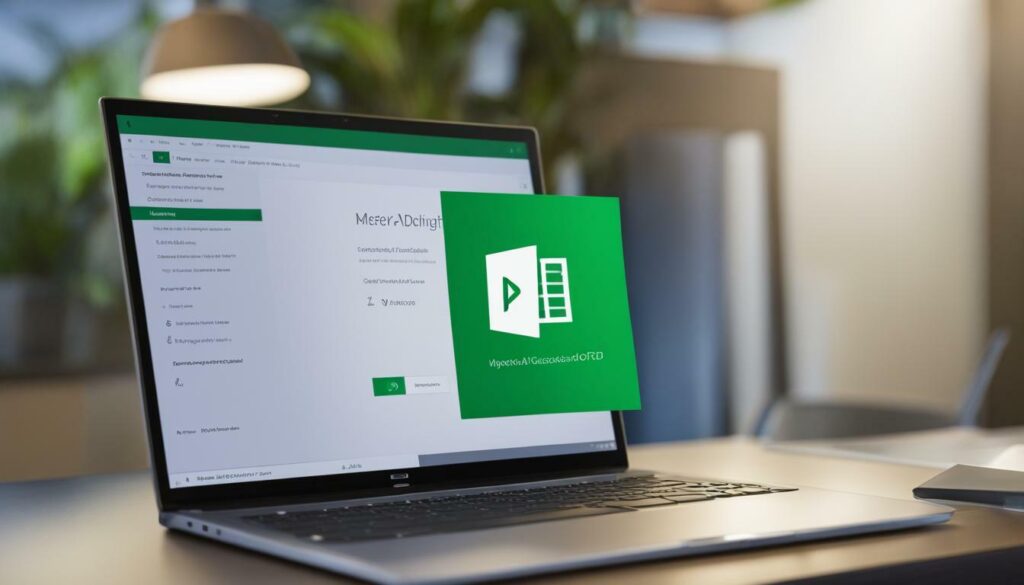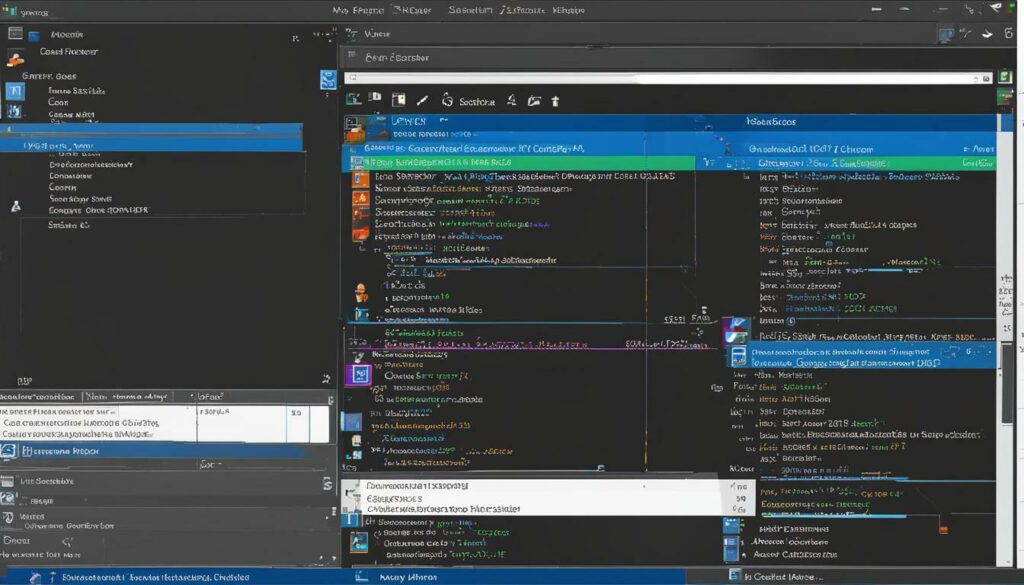In this section, we will explore the process of signing code in Visual Studio and how it can benefit coders at all skill levels. To ensure the security, integrity, and trustworthiness of your software and applications, signing code in Visual Studio is an essential step. By obtaining a code signing certificate from a trusted certificate authority (CA) and installing it on your computer or server, you can digitally sign your code and establish your identity as a verified and known publisher.
To begin the process of signing code in Visual Studio, you first need to obtain a code signing certificate. This certificate serves as proof that your software is authentic and has not been tampered with. It helps protect users from downloading and installing malicious software.
Once you have obtained the code signing certificate, you can install it on your computer or server. This will enable you to sign your software and applications in Visual Studio. Code signing works by creating a unique hash value that combines the software and the certificate. This hash value is then digitally signed using the certificate and key, creating a digital signature that verifies the authenticity and integrity of the code.
By signing your code in Visual Studio, you not only ensure the security and trustworthiness of your software but also protect users from potential threats. When users try to download the signed software, their browsers will generate a hash value for the file and compare it to the original one generated during the signing process. If the hash values match, it indicates that the software is safe to download.
Furthermore, code signing certificates are beneficial for signing updates to your software. By signing updates, you can protect your users from downloading and installing malicious updates that may compromise their systems. This adds an extra layer of security and helps maintain user trust in your software.
To sign code in Visual Studio, follow these steps:
- Right-click on the project in the Solution Explorer.
- Select Properties.
- Navigate to the Signing tab.
- Select the Sign the ClickOnce Manifests checkbox.
- Choose the code signing certificate you want to use.
- Specify the timestamp server.
- Start signing your code.
It is important to note that signing the ClickOnce manifests is optional for .exe-based applications. For testing purposes, you can also generate unsigned manifests. However, using unsigned manifests introduces security risks and should only be done in isolated intranet environments.
Key Takeaways:
- Signing code in Visual Studio is crucial for ensuring software security, integrity, and user trust.
- A code signing certificate from a trusted certificate authority (CA) is required to sign code in Visual Studio.
- Installing the code signing certificate on your computer or server enables code signing in Visual Studio.
- Code signing works by creating a unique hash value that combines the software and certificate, providing authenticity and integrity verification.
- Signing code in Visual Studio helps protect users from downloading and installing malicious software.
By following the steps mentioned above and signing your code in Visual Studio, you can enhance the security, trustworthiness, and user experience of your software and applications.
Why sign code in Visual Studio?
Signing code in Visual Studio using a trusted certificate authority (CA) helps validate your software and applications, establishing you as a verified and known publisher. Code signing is an essential process that brings numerous benefits, both for developers and end users.
First and foremost, code signing enhances software security. By digitally signing your code, you create a unique hash value that ensures the integrity and authenticity of your software. This prevents unauthorized modifications and tampering, protecting users from malware and other security threats.
Furthermore, code signing instills confidence and trust in your users. When they download your signed software, modern browsers will compare the hash value of the downloaded file with the original one generated during the signing process. If the hash values match, it indicates that the software has not been tampered with and is safe to use. This verification process reassures users that they are downloading software from a trusted source.
Benefits of code signing
Code signing offers several key benefits:
- Improved Security: By digitally signing your code, you protect it from unauthorized modifications and ensure its integrity.
- Trustworthiness: Code signing establishes your identity as a legitimate software publisher, building trust with your users.
- Protection Against Malicious Updates: Code signing allows users to verify the authenticity of software updates, safeguarding them against potential malware.
In conclusion, signing code in Visual Studio using a trusted certificate authority is a crucial step in software development. It not only enhances security but also builds trust and credibility with your users. By following the necessary steps to obtain and install a code signing certificate, you can ensure the integrity and authenticity of your software, establishing yourself as a reputable software publisher.
Obtaining a code signing certificate
To sign code in Visual Studio, you first need to obtain a code signing certificate from a trusted certificate authority (CA). This certificate acts as proof that you are a verified and trusted software publisher. Obtaining a code signing certificate involves a few simple steps:
- Research trusted certificate authorities: Look for reputable CAs that offer code signing certificates. Examples include Comodo, Symantec, and GlobalSign.
- Choose the right certificate type: Depending on your needs, you can opt for either a standard code signing certificate or an Extended Validation (EV) code signing certificate. The EV certificate provides an extra layer of trust and visibility to your software.
- Provide necessary documentation: CAs require certain documentation to verify your identity and legitimacy as a software publisher. This may include legal documents, proof of ownership, and identification.
- Complete the application process: Submit your application along with the required documentation to the chosen CA. The CA will review your application and, if approved, issue you a code signing certificate.
Once you have obtained the code signing certificate, you can proceed with the next steps to sign your code in Visual Studio.
Installing the code signing certificate
After obtaining a code signing certificate, the next step is to install it on your computer or server. Here’s how:
- Locate the code signing certificate file: The CA will provide you with a file containing the certificate in either .pfx or .p12 format. Make sure to save it in a secure location.
- Double-click the certificate file: This will open the Certificate Import Wizard.
- Choose the certificate store: Select the option to store the certificate in the current user’s personal certificate store.
- Complete the installation: Follow the prompts to install the certificate. You may need to enter a password that was provided by the CA.
Once the certificate is successfully installed, you can proceed to sign your code in Visual Studio.

Signing code in Visual Studio
Now that you have obtained and installed the code signing certificate, you can sign your code in Visual Studio to enhance its security and trustworthiness. Here’s a step-by-step guide:
- Open your project in Visual Studio.
- Right-click on the project in the Solution Explorer and select Properties.
- In the project properties window, navigate to the Signing tab.
- Check the “Sign the ClickOnce manifests” checkbox.
- Select the code signing certificate you want to use from the dropdown list.
- Specify the timestamp server to add an additional layer of security to your signed code.
- Click the OK button to save the changes.
- Build and publish your project to generate signed code.
By following these steps, you can ensure that your software is signed and validated, providing users with a trusted and secure application.
Installing the code signing certificate
Once you have obtained your code signing certificate, the next step is to install it on your computer or server to start signing your software. Installing the code signing certificate is a straightforward process. Here are the steps to follow:
- Open Visual Studio and select the project you want to sign code for.
- Right-click on the project in the Solution Explorer and select Properties.
- In the Properties window, navigate to the Signing tab.
- Check the “Sign the ClickOnce Manifests” checkbox, if applicable.
- Select the code signing certificate you want to use from the drop-down menu.
- If you haven’t already, download and install the certificate from the trusted certificate authority (CA).
- Specify the timestamp server for code signing validation.
- Click OK to save your changes.
By following these steps, you will be able to install the code signing certificate and proceed with signing your software in Visual Studio. It’s important to note that signing the ClickOnce Manifests is optional for .exe-based applications, but it’s recommended for added security and user trust.
Code signing plays a crucial role in software validation and protecting users from potential security risks. It verifies the integrity and authenticity of your software, giving users confidence in its source. With a valid code signing certificate installed, your software will be considered safe to download and use. Additionally, it helps prevent unauthorized or malicious updates, ensuring that users are not exposed to harmful software. Therefore, it is highly recommended to sign your code in Visual Studio using a trusted code signing certificate.
Table: Benefits of Code Signing
| Benefit | Description |
|---|---|
| Improved Security | Code signing verifies the integrity and authenticity of software, protecting users from tampering and malware. |
| Enhanced Trustworthiness | Users are more likely to trust and download software from verified publishers, increasing user adoption. |
| Protection Against Malicious Updates | Code signing prevents unauthorized or malicious updates, ensuring users receive genuine and secure software updates. |
Code signing is a vital step in the software development process, providing assurance to users and protecting against potential risks. By installing and utilizing a code signing certificate in Visual Studio, you can establish trust with your audience and ensure the integrity of your software.
Signing code in Visual Studio
To sign code in Visual Studio, you can follow these steps within the project properties in the code editor. First, right-click on the project in the Solution Explorer, and select Properties from the dropdown menu. This will open the project properties window.
Next, navigate to the Signing tab in the project properties window. Here, you will find the option to sign the ClickOnce manifests. Select the “Sign the ClickOnce Manifests” checkbox to enable code signing for your project.
After enabling code signing, you will need to select the code signing certificate you want to use. You can either use an existing certificate or obtain a new one from a trusted certificate authority (CA). The certificate helps validate your software and applications as a verified and known publisher.
In addition to selecting the certificate, you will also have the option to specify a timestamp server. This server ensures that your signed code remains valid even after the certificate expires. By including a timestamp, users can trust that the software was signed during the validity period of the certificate.
Once you have configured the signing settings, you can start signing your code by clicking the “Sign the assembly” button. Visual Studio will then generate a unique hash value by combining the software and certificate. This hash value is digitally signed using the certificate and key, providing an additional layer of security.

By following these steps, you can sign your code in Visual Studio, ensuring the authenticity and integrity of your software. Code signing certificates offer several benefits, including improved security, user trustworthiness, and protection against malicious software updates.
Remember, signing your code is an important step in software development, and it helps establish your credibility as a publisher. Don’t forget to obtain a code signing certificate from a trusted certificate authority before initiating the signing process in Visual Studio.
Summary:
- To sign code in Visual Studio, open the project properties window by right-clicking on the project in the Solution Explorer and selecting Properties.
- Navigate to the Signing tab and select the “Sign the ClickOnce Manifests” checkbox to enable code signing.
- Choose the code signing certificate you want to use and specify a timestamp server to ensure the validity of signed code.
- Click the “Sign the assembly” button to start the signing process, which combines the software and certificate to create a unique hash value.
- Code signing provides enhanced security, user trust, and protection against malicious software updates.
Benefits of Code Signing in Visual Studio
Code signing in Visual Studio offers several benefits, including enhanced security, improved trustworthiness, and protection against malicious software updates. By signing your code with a trusted certificate authority (CA), you establish your software as a verified and known publisher, giving users confidence in its authenticity and integrity.
One of the primary advantages of code signing is enhanced security. When a user downloads your signed software, their browser generates a hash value for the file and compares it to the original one generated during the signing process. If the hash values match, the software is considered safe to download. This verification process helps protect users from tampered or malicious software, reducing the risk of unauthorized access or data breaches.
In addition to security, code signing improves trustworthiness. Users are more likely to trust software from publishers with a code signing certificate, as it assures them that the software has not been altered or compromised. This increased trust can lead to higher adoption rates for your software, as users feel confident in its reliability and legitimacy.
Furthermore, code signing provides protection against malicious software updates. By signing updates, you can verify that they come from a trusted source and have not been tampered with during distribution. This ensures that users receive legitimate updates and helps safeguard their systems from potential vulnerabilities.
Summary:
- Code signing in Visual Studio enhances security and protects against malicious software.
- It improves trustworthiness and reassures users of a software’s authenticity.
- By signing updates, it prevents the distribution of tampered or compromised software.
| Benefits of Code Signing in Visual Studio | Summary |
|---|---|
| Enhanced security | Code signing protects against tampered or malicious software, reducing the risk of unauthorized access or data breaches. |
| Improved trustworthiness | By verifying the authenticity and integrity of software, code signing instills trust in users and increases adoption rates. |
| Protection against malicious updates | Signing updates ensures their legitimacy and safeguards systems from potential vulnerabilities. |
Conclusion
Signing code in Visual Studio is an essential practice for verifying the authenticity and integrity of software applications, providing users with confidence and security. By obtaining a code signing certificate from a trusted certificate authority (CA), developers can validate their software as a verified and known publisher. This certificate is used to sign the software by creating a unique hash value that is digitally signed using the certificate and key. When users try to download the signed software, their browser generates a hash value for the file and compares it to the original one generated during the signing process. If the hash values match, the software is considered safe to download.
In addition to validating software, code signing certificates are also valuable for signing updates and protecting against malicious software updates. By signing updates, developers can ensure that only trusted and authorized updates are installed, safeguarding users from potential security threats.
To sign code in Visual Studio, developers can follow a simple process. They need to obtain a code signing certificate, install it on their computer or server, and configure the necessary settings in Visual Studio. This typically involves right-clicking on the project in the Solution Explorer, selecting Properties, navigating to the Signing tab, enabling the option to sign the ClickOnce Manifests, selecting the code signing certificate, and specifying the timestamp server. Following these steps allows developers to start signing their software and providing users with the trust and security they deserve.
FAQ
Q: How do I sign code in Visual Studio?
A: To sign code in Visual Studio, you need to obtain a code signing certificate from a trusted certificate authority (CA). Once you have the certificate, you can install it on your computer/server and follow the steps provided in the article to sign your software.
Q: Why should I sign code in Visual Studio?
A: Signing code in Visual Studio helps validate your software and applications as a verified and known publisher. It improves user trust, protects against malicious software updates, and enhances security.
Q: How do I obtain a code signing certificate?
A: To obtain a code signing certificate, you need to contact a trusted certificate authority (CA) and follow their application process. Once approved, you will receive the code signing certificate.
Q: How do I install the code signing certificate?
A: After obtaining the code signing certificate, you can install it on your computer or server by following the instructions provided by the certificate authority (CA). This process may vary depending on the operating system you are using.
Q: What are the steps to sign code in Visual Studio?
A: To sign code in Visual Studio, you can follow these steps: right-click on the project in the Solution Explorer, select Properties, navigate to the Signing tab, select the Sign the ClickOnce Manifests checkbox, select the code signing certificate you want to use, specify the timestamp server, and start signing. More detailed instructions can be found in the article.
Q: What are the benefits of code signing?
A: Code signing offers several benefits, including improved software validation, enhanced user trust, protection against malicious software updates, and heightened security for your applications.






